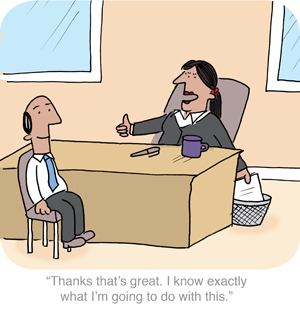OPINION22 January 2013
All MRS websites use cookies to help us improve our services. Any data collected is anonymised. If you continue using this site without accepting cookies you may experience some performance issues. Read about our cookies here.
OPINION22 January 2013
Former clientside researcher and Insight Inside founder Andy Howden reveals 10 reasons why insight can struggle to gain traction within business.
So we set out to understand why insight sometimes fails to gain traction. We asked 30 heads of insight and marketing directors to explore with us how effectively insight is working in their business and how it could work better.
Here’s what we found:
Some organisations in our survey had a clear definition of what insight is and a vision about the role of the insight team. But where we encountered businesses with major concerns about their insight delivery, this was often linked to a lack of shared purpose and goals.
We heard how insight teams can benefit from behaving more like a brand with a clear proposition and an understanding of their target audience. This can help them to set priorities, which is critical when there are multiple stakeholders making multiple demands.

Insight specialists typically commented on how important it was to have someone at a C-suite or marketing director-level that helped set the agenda for insight. Certainly there were cases of insight being elevated or relegated in status following a change at the top.
The key to success here seems to be to have a clear strategy for addressing those who are already onside with the insight agenda as well as those who aren’t. The best insight operators engage with those senior stakeholders who really get insight while also looking for ways to ‘smuggle’ insight in front of those who don’t see the value of it. With the latter, a five-minute corridor conversation can be worth more than the debrief they never attend.
We need to avoid sweeping generalisations, but if we use the Myers Briggs definitions of personality types it was often recognised that insight people are more “introvert (I)”, while quantitative insight people in particular tend to be “sensors (S)” – people who are detail- and evidence-focused. Marketers, by contrast, are more often seen as “extrovert intuitives (E&N)” who talk about new ideas but might gloss over detail. Insight teams might therefore worry that their carefully considered insights aren’t being fully appreciated in the more hunch-driven marketing environment where he (or she) who talks loudest talks last. These differences can hinder effective teamwork between the functions, while also inhibiting insight practitioners from pushing their own agenda.
Many insight heads referenced the need for their team to actively fight their corner and be heard. But equally some marketers admitted that they might need to give insight a little more opportunity to be heard. It might be that better listening skills are required, as well as the creation of forums to connect insight and marketing skills more effectively.
Demand for insightful people has grown but not every business has clearly defined the skills and behaviours these people should have. Many businesses feel they don’t have all the individuals they need but struggle to recruit them due to a lack of clarity in the spec.
So what makes a good insight person? Firstly, they need a bendy brain which thinks laterally and makes connections across different pieces of information. But they also need intellectual curiosity to challenge and go beyond the findings and ask ‘why?’ And stakeholders want them to ally these skills to a more commercial mindset. This is not a denial of the importance of great technical skills – which some felt had been overlooked in recent years. But insight skills are broader and imply an ability to use technical skills to deliver something critical for business.

When insight doesn’t cut through it’s often because insufficient emphasis has been placed on how to engage the internal audience. Client insight teams sometimes criticise agencies for this, feeling that they often present findings which are too unwieldy to be inspiring, and that they as clients have to turn it into insight.
Yet it was rare to find a business which actually devoted meaningful budget to communicating insights rather than just spending money on trying to uncover them, while some agreed that communication often isn’t sufficiently tailored to specific audiences. Several respondents spoke about needing to think of stakeholders as they would consumers. When it comes to communicating with them, consider the message, execution, medium and moment.
Businesses often realised that they were not making the most of what they already had. Sometimes knowledge management systems were criticised for failing to organise findings and insights in a way that was engaging and accessible, and there were also multiple instances of poor knowledge transfer – i.e. different teams within different categories or geographies not learning from each other’s work. But frequently the problem was getting the right mix of people in a room together to make the connections and work the insight from various angles.
Insight teams often talked about how they are now required to demonstrate return on investment from projects. It’s a fair challenge for insight to focus on helping the business answer tough commercial questions – but there might not always be a straight line connecting insight to financial benefit. It seems that the critical questions to ask are, “Why are we doing this work?” and “What will we do with the results?”

With increasing time pressures, there is sometimes a sigh of relief and a feeling of “job done – onto the next one” at the end of a debrief. Yet all acknowledge that what happens next is equally critical. And many felt that more time was needed to ensure that insights were applied effectively at this stage.
The extent to which insights are applied can relate to the influence of the insight specialists and their relationship with key stakeholders. But consistency of approach is also a key success factor. Many could report on a specific case when insight had really been applied to help develop or improve a new product or service, but it seemed to be occasional rather than repeated best practice. The more successful businesses recognised that applying insight regularly is hard work and requires tenacity from insight people but also consistent frameworks to make it happen – from simple processes such as producing summaries of insights from each project, to regular communication or follow-up sessions to ensure insights are embedded and used.
Future-oriented thinking is still seen as quite a rare commodity. Research people are often called upon to measure what has happened, but there’s a sense that the balance leans too much towards looking in the rear-view mirror with not enough focus on the road ahead. Achieving a better fusion of insights to foresights may require a different type of insight person – an ‘imaginator’ perhaps.
Some respondents admitted that insufficient thinking time was devoted to budget planning or that re-aligning the budget to changing strategic priorities involved too much arm-wrestling. Certainly some research happens because it has always happened – but it was often felt by insight teams that the focus on old favourites can leave little room for the more discretionary work which might yield more ground-breaking insights.
Andy Howden is a founder director of Insight Inside, an independent consultancy which advises clients on how to maximise the effectiveness of insight within their organisation. He has worked in research and insight for 30 years, both as a clientside researcher for ICI and Unilever, and as a board director for Added Value
3 Comments
Andrew Longward
11 years ago
A very good summary of the challenges faced by client side research team's. I believe that there's been a step change in the last few years due to the recession but if the team embraces the change and can adapt a sales culture, then they can really start to make a difference going forward.
Like Reply Report
Julia Fine
11 years ago
The differences in personality types was most insightful here. Now, I continue my struggle in how to reconcile being a sensor with having to make presentations appealing to extrovert intuitives?
Like Reply Report
Lucy Davison
11 years ago
An interesting piece, summed up for me in the comment: "it was rare to find a business which actually devoted meaningful budget to communicating insights rather than just spending money on trying to uncover them". For insight to have impact, it needs to be communicated creatively powerfully and professionally. This is something I have seen many researchers (agency and client side) struggle with for a long time. It might be researchers are the 'wrong' personality type, but what a great opportunity for researchers to work with marketing personality-type people in the communication of their own insights. Please researchers, put your money where your mouth is and team up with great communicators to ensure your insights are heard, used and valued!
Like Reply Report